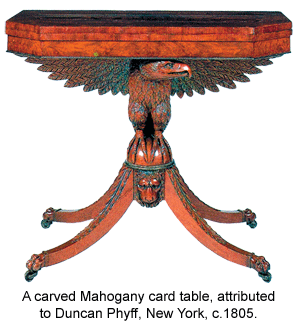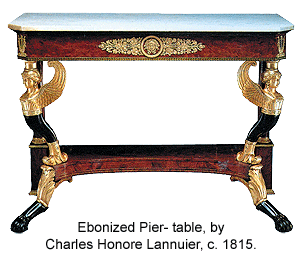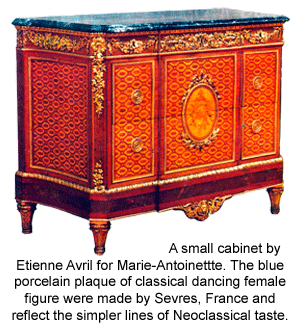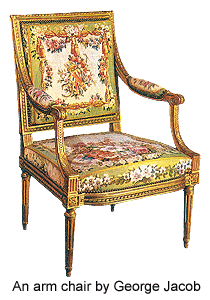- Prelude
- Hard Talk
- New Media
- Rolex : An Overview
- The age of Revivals: Neoclassical Furniture
- Democratization of the Medium No-Budget film: the Indian Context (!)
- Old Sound New Sound
- Decan Odyssey
- North East Opsis
- Russian cool breeze in hot Paris
- Around Kolkata
- Musings from Chennai
- In and around Santiniketan
- In between – from Vadodra
- A Tryst with Art in Madhya Pradesh
- Through the Looking Glass
- The Foreign Connection
- Market Insight
- Market Report
- Artist Index and Statistics
- Auction Reports
- The month that was
- Delhi Dias
- Art Bengaluru
- Mumbai Art Sighting
- Creative Impulse
- Subodh Gupta
- Pooja Iranna
- Preview
- In the News
ART news & views
The age of Revivals: Neoclassical Furniture
Volume: 2 Issue No: 9 Month: 10 Year: 2010

In the Beginning of 18th century the agricultural revolution spread across Britain, Europe, and Americas. With new methods of farming and intense labour there was tremendous production of agricultural products which led to surplus in food production.  This resulted in pulling down the prices and farmers prosperity increased, the farmers started to move towards rapidly expanding towns. In 1760, a second revolution got under way in Britain as industrial revolution. With the new machinery powered by coal and water, the steam engine revolutionized the manufacture of textile and eventually led to mass production of furniture and other household goods.
This resulted in pulling down the prices and farmers prosperity increased, the farmers started to move towards rapidly expanding towns. In 1760, a second revolution got under way in Britain as industrial revolution. With the new machinery powered by coal and water, the steam engine revolutionized the manufacture of textile and eventually led to mass production of furniture and other household goods.
Alongside both the revolutions was a cultural revolution known as Enlightment, a philosophical attempt to rationalize the replacement of customs, traditions, and religion with reason and natural law. It was a period of two of the most important political revolution in history, The American Revolution of 1776 against British colonial rule that led to the independence of the United States of America; and the French Revolution of 1789 that overthrew the monarchy and introduced new ideas of liberty, equality and fraternity.
Just as the Enlightment Philosophers looked back to the ordered classical world for inspiration, the designers of this period took inspiration from the same classical world giving birth to the movement we now call Neoclassicism. It is used to refer the style of art, architecture, and design that was concerned with ideals of the classical world and which flourished in the late 18th century. The intellectuals and travelers of the period revered the classical world of ancient Greeks and Romans. With the discovery of ancient Roman villas and their furnishings in Pompeii and Herculaneum after 1738, the craze for the Classical world was unleashed. It began with the application of decorative Classical motifs and the principle of symmetry to architecture. Various artists and architects published great tomes illustrating the ancient world, thus creating a demand for more accurate Classicism rather than just a reworking of Italian Renaissance and Baroque architecture. It then spread to interior design, notably furniture, as well as to painting, pottery, glass, and tapestry, totally transforming the environment and style of the period.
Various artists and architects published great tomes illustrating the ancient world, thus creating a demand for more accurate Classicism rather than just a reworking of Italian Renaissance and Baroque architecture. It then spread to interior design, notably furniture, as well as to painting, pottery, glass, and tapestry, totally transforming the environment and style of the period.
France was the first country to embrace neoclassical design, by the middle of the eighteenth century the Rococo style had already reached the climax of its development. Critics in more advanced Parisian circles began to speak out against its extravagant sinuous forms and to demand a return to a noble, more sober Classicism. The inevitable reaction against the Rococo had begun. The French barometer of taste, the Comte de Caylus (1692-1765), was instrumental in introducing Classicism, including classical furniture, to France.
 French neoclassical furniture tends to be rectangular and lacks curves. This did not happen at once, as larger pieces often remained in stock after fashions had changed and cabinet- makers adapted the Rococo forms by applying neoclassical decoration. In this French transitional style, serpentine shapes gradually straightened and cabriole legs evolved into turned or tapered legs. Chair backs were rectangular or oval with turned legs, often fluted in reference to Classical architectural columns.
French neoclassical furniture tends to be rectangular and lacks curves. This did not happen at once, as larger pieces often remained in stock after fashions had changed and cabinet- makers adapted the Rococo forms by applying neoclassical decoration. In this French transitional style, serpentine shapes gradually straightened and cabriole legs evolved into turned or tapered legs. Chair backs were rectangular or oval with turned legs, often fluted in reference to Classical architectural columns.
The French neoclassical furniture is described in three phases of styles namely, Louis XVI style, Directoire style and Empire style. Louis XVI neoclassical style of decoration was already popular by the time of Louis XVI's accession to throne in 1774. It also shows traces of influence from the restrained baroque of Louis XIV. It was succeeded by the Directoire style in 1795, an art form characterized by clarity, restraint, and balance. It mingled the neo-Classical elements with republican motifs such as the faces and cap of liberty. An X shaped stool in Directoire style is based on a Roman Imperial model.  The lion's head finials and animal-paw feet are also borrowed from classical originals. Empire Style is a late version of neo-Classicism popular in France during the first Napoleonic Empire, and particularly associated with the types of furniture and decoration Ordered by the Emperor Napoleon for his residences which are characterized in particular by Antique forms and lavish draperies. The empire style was influential throughout Europe and also in North America.
The lion's head finials and animal-paw feet are also borrowed from classical originals. Empire Style is a late version of neo-Classicism popular in France during the first Napoleonic Empire, and particularly associated with the types of furniture and decoration Ordered by the Emperor Napoleon for his residences which are characterized in particular by Antique forms and lavish draperies. The empire style was influential throughout Europe and also in North America.
Neoclassic furniture in eighteenth century England is first seen in the works of Sir William Chambers and James Stuart. Chambers had been to Rome and Paris and later developed a style that let go of the cabriole leg in favour of straight lines and narrow tapering legs adorned with twisted fluting. But the greatest contribution of neoclassicism in England was from Robert Adam. Robert Adam studied in detail the Roman classical ornaments in Italy and applied them into designing room interiors in Roman style. He not only made furniture, but, when set to the task, would design and decorate whole rooms down  to the last detail, all in the same neoclassical style. The style and designs of Adam influenced many contemporary designers. Most famous of them was George Hepplewhite. He in 1788 published a pattern book “Cabinet-makers and Upholsterer's Guide” largely based on Adam's design but in simplified way, more suited to the needs of everyday craftsmen. The final phase of neoclassicism is seen in the works of Thomas Sheraton. Sheraton furniture had a huge practical impact and produced very elegant, sophisticated furniture in the neoclassical style in great numbers.
to the last detail, all in the same neoclassical style. The style and designs of Adam influenced many contemporary designers. Most famous of them was George Hepplewhite. He in 1788 published a pattern book “Cabinet-makers and Upholsterer's Guide” largely based on Adam's design but in simplified way, more suited to the needs of everyday craftsmen. The final phase of neoclassicism is seen in the works of Thomas Sheraton. Sheraton furniture had a huge practical impact and produced very elegant, sophisticated furniture in the neoclassical style in great numbers.
Neoclassicism in America has three parallel phases, Federal 1780-1820, Empire 1820-1840 and Late Classicism 1835-1850. The designs of Robert Adam from England was the first influence on the neoclassicism in America, although the revolution and a consequent diminished liking for English fashions delayed and to some extent prevented the complete adaptation of this Adam classicism here. It became the main inspiration for most of American design around 1800 and was labeled as “Federal”. This style is usually described by and contributed to the names of Sheraton and Hepplewhite.  The style reached America by way of British pattern books and an ever-swelling wave of masons, carpenters, and joiners who emigrated from England. The Empire style and late classical are often regarded by many scholars as one and same. The Empire style was first introduced in America by a French emigrant, Charles-Honore` Lannuier in New York between 1803 and 1819, he combined belated Louis XVI and early Empire designs. In the 1820s and 1830s Duncan Phyfe was the most popular Empire furniture manufacturer in America.
The style reached America by way of British pattern books and an ever-swelling wave of masons, carpenters, and joiners who emigrated from England. The Empire style and late classical are often regarded by many scholars as one and same. The Empire style was first introduced in America by a French emigrant, Charles-Honore` Lannuier in New York between 1803 and 1819, he combined belated Louis XVI and early Empire designs. In the 1820s and 1830s Duncan Phyfe was the most popular Empire furniture manufacturer in America.
Empire became an international style, with Scandinavian, German, Italian, Russian, and American interpretations. The basic concept was constant, with ancient prototypes adapted to 19th-century taste. The major change, besides the increase in archaeological influence, was in scale. Designers were attempting to regain the sense of monumentality that had been lacking since the beginning of the 18th century, when it was diminished to achieve the human scale then desired. In the German-speaking areas, the style, recognized as typically middle class, has been called Biedermeier, after a comic character who was supposed to satirize middle-class tastes. The name was applied as the style was going out of fashion in about 1850. Under whatever name, Empire was a lasting style; introduced before 1800, it did not disappear completely until the middle of the 19th century.
Amitabh Bachhawat